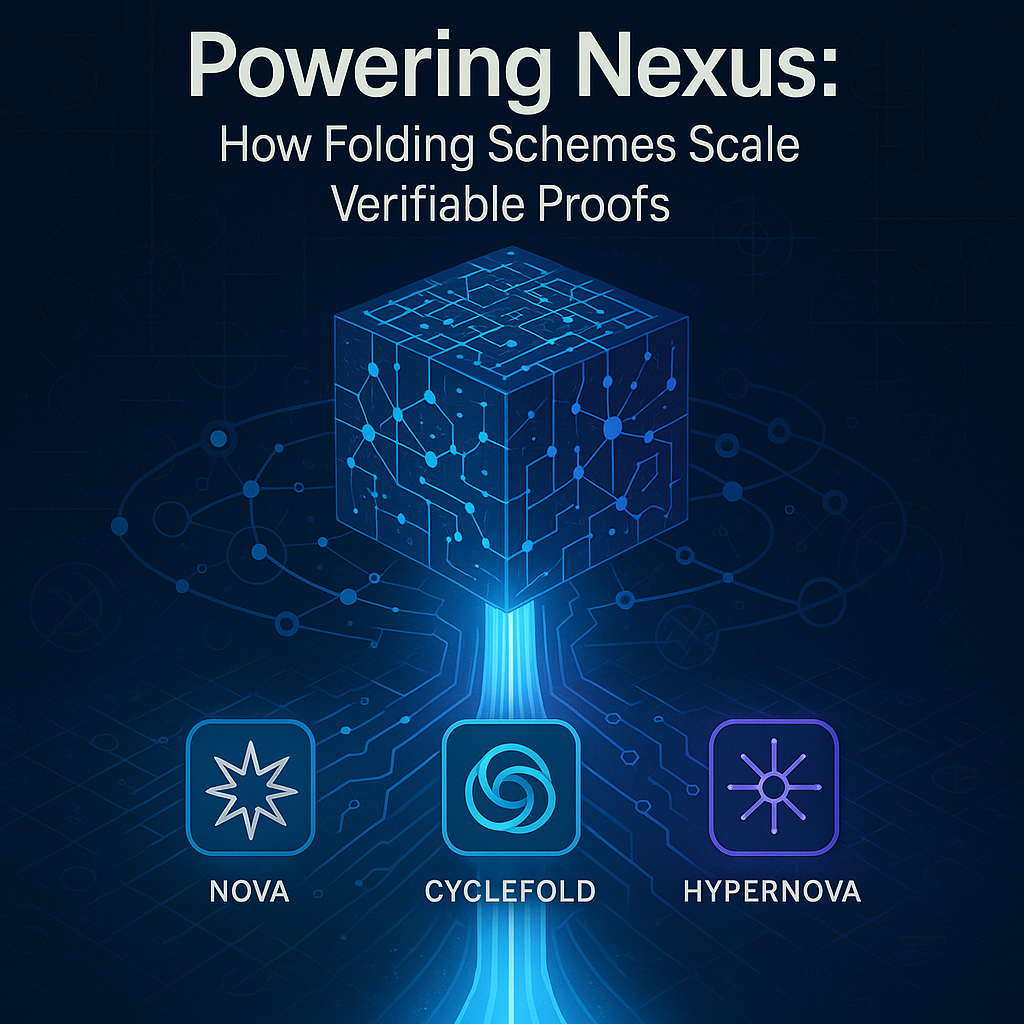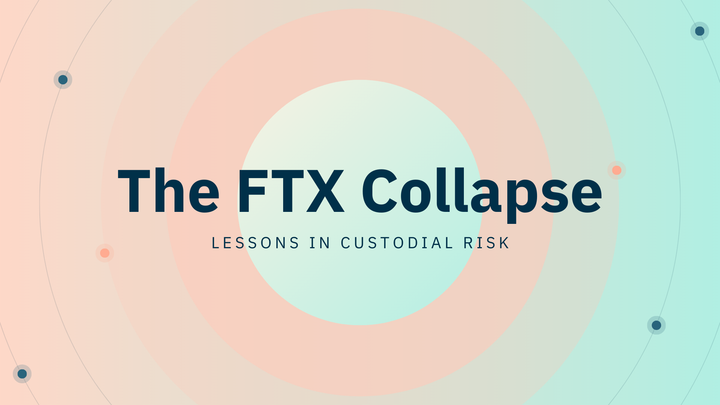Powering Nexus: How Folding Schemes Scale Verifiable Proofs

The Nexus project aims to transform computation by enabling verifiable proofs at Internet scale, uniting global computers into a trustless supercomputer Our prior articles laid the groundwork: “Verifiable Computation at Scale” introduced the Nexus zkVM as a universal prover for any program, “The Nexus Virtual Machine” explored the NVM’s prover-optimized design, and Scaling Verifiable Computation highlighted the Nexus Network’s distributed proving power. At the heart of this vision lie folding and accumulation schemes—cryptographic innovations that make massive, parallelized proof generation efficient. This article delves into how schemes like Nova, CycleFold, and HyperNova enable Nexus to overcome traditional proof system limitations, scaling verifiable computation to unprecedented levels.
In a simple term:
Imagine you're trying to bake a giant cake for the whole world—but it's too big for one oven. So, you ask lots of friends in different kitchens to each bake a tiny piece of the cake.
Now, here’s the tricky part: how do you know everyone followed the recipe correctly without tasting every single piece?
That’s where Nexus comes in! Nexus is like a magical recipe checker. Each kitchen sends in a secret-proof that says, “I followed the recipe!”...and Nexus uses a special cooking spell (called zero-knowledge proofs) to check all the cakes without seeing how they were made.
But checking every piece one by one is slow… so Nexus uses clever tricks (called folding and accumulation) to mix all the proofs together into one tiny, easy-to-check cupcake. Just taste that cupcake, and boom...you know the whole cake is perfect!
That’s how Nexus makes baking (a.k.a. computing) super fast, safe, and big enough for the whole internet.
The Challenge of Massive Proofs
Proving a program with billions of execution steps or aggregating proofs across a distributed network poses significant cryptographic challenges. Traditional recursive SNARK composition, where each proof verifies the previous step’s verifier, is computationally expensive and memory-intensive, requiring large machines (e.g., ~100 GB RAM) and complex circuits. The Nexus zkVM avoids this bottleneck by leveraging folding and accumulation schemes, which aggregate computational statements efficiently, deferring heavy verification to a final step.
Proving really big programs or combining many proofs from different computers is usually slow and needs powerful machines. Traditional methods check each step one by one, which uses a lot of memory and time.
The Nexus zkVM solves this by using smart shortcuts called folding and accumulation. These let it group many computations together and wait until the end to do the heavy checking...making the whole process faster and more efficient.
Folding: Efficient Proof Aggregation
Folding schemes combine multiple instance-witness pairs—representing computation steps or partial proofs—into a single, valid pair, preserving cryptographic integrity via knowledge soundness. Unlike SNARK recursion, which verifies each proof individually, folding operates on the underlying Customizable Constraint Systems (CCS), using additive homomorphism of commitment schemes like Pedersen. This process is lightweight, requiring only a multi-scalar multiplication (MSM) per step, noted for its low prover overhead. The final folded instance is verified with a single zk-SNARK, minimizing costs.
CCS, a generalization of R1CS and Plonkish, offers flexibility for complex computations, enabling Nexus to support diverse applications. This efficiency is amplified by zkVM co-processors, which optimize specific operations (e.g., SHA-256) to complement folding, ensuring high performance without sacrificing the NVM’s simplicity.
Simplified-Optional
Imagine a teacher who gives homework to 100 students.
Normally, the teacher would check each student's paper one by one—slow, tiring, and takes a lot of space on the desk.
But now, imagine a smart system where each student summarizes their work into a small card and passes it to the next. At the end, the last student hands one single card to the teacher. This final card proves that everyone did their homework correctly, without the teacher needing to see every paper.
That’s what folding does in cryptography. Instead of checking every proof individually (like checking every student's homework), it combines them into one small, final check—fast and space-saving.
The Nexus zkVM even uses special calculators (co-processors) to help students do tricky math faster (like big equations), so the whole class finishes quicker without mistakes.
Key Folding Schemes in Nexus
Nexus implements three open-source, Rust-based folding schemes, each tailored to specific challenges:
- Nova: Enables Incrementally Verifiable Computation (IVC) without SNARKs for sequential steps, ideal for long computations.
- CycleFold: Handles folding over a 2-cycle of elliptic curves, optimizing arithmetic for parallel proving.
- HyperNova: Extends folding to CCS, supporting expressive computations with custom constraints.
These schemes, built in the arkworks framework, achieve production-grade performance (e.g., 50k constraint overhead for Nova) and are accessible to the community. Nexus aims to prove trillions of CPU cycles per second, with ongoing optimizations to reduce overhead further.
Simplified-Optional
Imagine three special machines in a giant factory (Nexus) that help package homework from thousands of students super fast:
- 🧠 Nova is like a conveyor belt that checks each paper one after the other—perfect for really long homework chains. It doesn’t need a teacher to check every time, just the belt moving and checking bits as it goes.
- ⚙️ CycleFold is like having two teams handing papers back and forth, each helping the other finish quicker. This teamwork makes checking lots of papers at once easier and faster.
- 🧩 HyperNova is the most flexible—it’s like a robot that can handle any kind of homework, even weird ones with custom rules. It’s made for the complex stuff.
These "machines" are built using open-source Rust code, so anyone can use or improve them. Nexus is tuning them to someday check trillions of steps per second—like correcting all the homework in the world, instantly.
Enabling the Nexus Network
Folding schemes are critical to the Nexus Network, which aggregates proofs in a tree-like structure across distributed provers . This leverages Proof-Carrying Data (PCD), a generalization of IVC that enables distributed proof computation with provable integrity. Each prover generates instance-witness pairs, which are folded rapidly in parallel, requiring minimal resources (e.g., 1GB RAM). The r-ary proof accumulation tree organizes this process, with each node representing a folded instance, culminating in a single root instance for verification. This parallelism, driven by Nova, CycleFold, and HyperNova, allows Nexus to scale proof generation proportionally to the Network’s collective power, a key enabler of its supercomputing vision.
Practical Impact: A Hash Chain Example
Consider proving a chain of SHA-256 hashes, a common task in blockchain verification. Traditional SNARK recursion would prove each hash iteratively, incurring high costs. With Nexus, provers fold hash computations into a single instance using HyperNova, leveraging a SHA-256 co-processor for efficiency. The Nexus Network aggregates these proofs in parallel, and a final zk-SNARK verifies the result, proving correctness with minimal overhead. This approach supports diverse computations, from recursive proof composition to complex algorithms, enabling applications like secure data processing or verifiable simulations.
Trade-Offs and Considerations
While folding schemes are efficient, they produce larger intermediate proof sizes compared to SNARKs, requiring final compression to achieve succinctness. Additionally, co-processors, while powerful, require manual circuit implementation, a one-time cost for specialized tasks. These trade-offs are mitigated by Nexus’s parallelized proving and open-source optimizations, ensuring practicality for large-scale applications.
Conclusion
Folding schemes like Nova, CycleFold, and HyperNova are the cryptographic backbone of the Nexus zkVM, enabling efficient, parallelized proof generation for massive computations. By aggregating proofs with low overhead and leveraging CCS, co-processors, and PCD, Nexus overcomes the limitations of SNARK recursion, scaling verifiable computation to Internet levels. These innovations, rooted in decades of research, realize Nexus’s vision of a verifiable supercomputer, ensuring computational integrity through mathematical truth.
Similar Articles
zk‑SNARKs to zk‑STARKs: The Evolution of Zero‑Knowledge in Web3
Succinct SP1 zkVM: Democratizing Zero-Knowledge Proofs for Rust Developers
🧬 How Replacing the EVM with RISC-V Could Accelerate Mitosis’ Programmable Liquidity Vision
The Future of Web3 Security: Verifiability Without Visibility Using zkTLS and FHE
Unpacking Blockchain's Engines: A Comprehensive Look at Virtual Machines



Comments ()